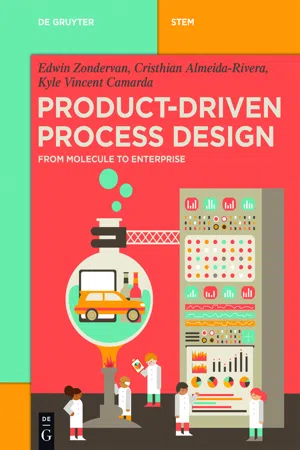
Product-Driven Process Design
From Molecule to Enterprise
- 528 pages
- English
- ePUB (mobile friendly)
- Available on iOS & Android
Product-Driven Process Design
From Molecule to Enterprise
About this book
Product-driven process design – from molecule to enterprise provides process engineers and process engineering students with access to a modern and stimulating methodology to process and product design.
Throughout the book the links between product design and process design become evident while the reader is guided step-by-step through the different stages of the intertwining product and process design activities. Both molecular and enterprise-wide considerations in design are introduced and addressed in detail. Several examples and case studies in emerging areas such as bio- and food-systems, pharmaceuticals and energy are discussed and presented. This book is an excellent guide and companion for undergraduate, graduate students as well as professional practitioners.
Frequently asked questions
- Essential is ideal for learners and professionals who enjoy exploring a wide range of subjects. Access the Essential Library with 800,000+ trusted titles and best-sellers across business, personal growth, and the humanities. Includes unlimited reading time and Standard Read Aloud voice.
- Complete: Perfect for advanced learners and researchers needing full, unrestricted access. Unlock 1.4M+ books across hundreds of subjects, including academic and specialized titles. The Complete Plan also includes advanced features like Premium Read Aloud and Research Assistant.
Please note we cannot support devices running on iOS 13 and Android 7 or earlier. Learn more about using the app.
Information
Part I Process Design
1 Introduction
1.1 The current setting of process industry
“We cannot solve our problems with the same thinking we used when we created them.”(Albert Einstein, 1879–1955)
1.2 The development of the PDPS approach
“The task is not so much to see what no one has yet seen, but to think what nobody yet has thought about that which everybody sees.”(Arthur Schopenhauer, 1788–1860)
Table of contents
- Title Page
- Copyright
- Contents
- Foreword
- Part I Process Design
- Part II Process Design Principles
- A Appendix
- Subject Index